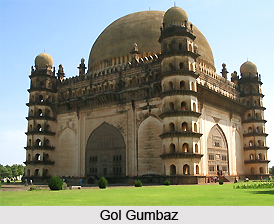 Sikander Adil Shah ascended the throne of the kingdom of Bijapur in 1672, at the tender age of four. The period of 1672 till 1686 was marked by the reign of Sikander Adil Shah, which consisted of frequent wars. The battles were fought mainly between ministers and nobles with the objective of gaining independence from provincial governors. There were numerous Mughal invasions during the rule of this emperor and secret alliances with the Marathas. Eventually, Bijapur was annexed by the Mughal Empire in 1686.
Sikander Adil Shah ascended the throne of the kingdom of Bijapur in 1672, at the tender age of four. The period of 1672 till 1686 was marked by the reign of Sikander Adil Shah, which consisted of frequent wars. The battles were fought mainly between ministers and nobles with the objective of gaining independence from provincial governors. There were numerous Mughal invasions during the rule of this emperor and secret alliances with the Marathas. Eventually, Bijapur was annexed by the Mughal Empire in 1686.
Sikander Adil Shah was insulted by the many internal conflicts which perturbed his empire, and for which Diler Khan, the Mughal General was responsible. He made some brave attempts to retrieve his kingdom from the Mughals, but all his efforts were in vain since the Mughals refused to give up Adil Shah`s empire. Sikander Shah`s alliance with Sambhaji went a step further to sour the relationship between the king of the then empire of Bijapur and the Mughals.
Finally, the Mughal emperor Aurangzeb was determined to conquer Bijapur and initiated his progress by laying a siege around Bijapur in about 1685 to 1686. Sikander Shah was not capable of checking the advancement of Aurangzeb into his empire. He was compelled to surrender Bijapur Fort and Bijapur was absorbed into the Mughal Empire.
Aurangzeb had ensured that Sikander Adil Shah captured in silver chains and brought in front of him. Sikander Shah and his companions were sent away to Daulatabad Fort, where he had died in captivity. He was buried in the open compound in the New Market area of Bijapur. This led to the decline of the Adil Shahi Dynasty.
This article is a stub. You can enrich by adding more information to it. Send your Write Up to content@indianetzone.com



















